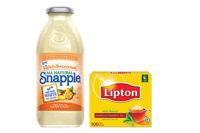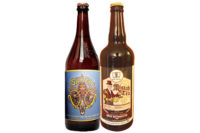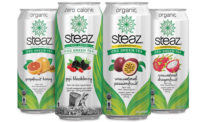Following Seattle-based Starbucks Coffee Co.’s acquisition of Atlanta-based Teavana Holdings Inc. at the end of 2012, the tea industry is waiting for the hot tea segment to boom, according to experts. “Interestingly, it really depends on what Starbucks does,” says Jonas Feliciano, beverage industry analyst for Euromonitor International, Chicago. “If they put a big push behind it because of the Teavana purchase, we could see it really take off in mainstream. Tea has been waiting for someone to make a big move on it.”
The existence of on-premise tea shops and cafés, like Teavana and Chicago-based Argo Tea, is making it more convenient for consumers to buy tea on-premise and boosting the beverage’s overall prominence, says Agata Kaczanowska, beverage industry analyst for Santa Monica, Calif.-based IBISWorld. This tea presence, in turn, boosts tea’s popularity in other on-premise channels because consumers are more likely to consider tea as a beverage option while dining out, she says. To support this consumer interest, more restaurant owners are offering tea and highlighting it on their menus, she adds.
In Packaged Facts’ February 2012 report, “Coffee and Tea Foodservice Trends in the U.S.,” the Rockville, Md.-based market research firm forecasted that tea sales would attain $8.7 billion in sales in restaurants and on-premise beverage establishments, such as cafés, in 2012. In addition, it predicted that tea’s continued growth would come from operators supplementing coffee platforms with tea drinks.
George Jage, founder and director of World Tea Media, Las Vegas, has found this to be true. “Many coffee retailers have shared with me that their tea sales have gone from the low single digits in the late ‘90s to now nearing 20 percent of their overall beverage sales,” says the organizer of World Tea Expo, Healthy Beverage Expo and the North American Tea Championship, among other events.
As tea continues to gain traction in the mainstream arena and consumers become educated about the quality and origin of the beverage, a tea culture is brewing with interest in specialty blends, loose-leaf teas and other premium offerings, Euromonitor’s Feliciano says. “There’s a premium culture that you see with consumers starting to gain an appreciation for the different types of teas available, whether they’re loose-leaf teas, herbal teas, fruit teas [or] specialty teas,” he explains. “There are a lot of subtleties to tea that have really high potential, but there’s just not a lot of consumer awareness yet.”
As this tea culture percolates, it’s also driving growth in terms of value but not necessarily volume for the beverage segment, Feliciano notes. From 2011 to 2012, hot tea experienced a 4 percent decline in volume but a 4 percent increase in value, which represents a premiumization trend in the category. Consumers are willing to pay more for high-quality teas and even pay a premium to purchase these products on-premise, he says.
IBISWorld estimates that loose-leaf tea accounts for approximately 26 percent of the $987 million brewed tea market, while specialty and gourmet teas make up another 18.5 percent.
However, the subtleties of this premium loose-leaf tea culture can make it difficult for all consumers to participate, experts say. According to Chicago-based Mintel’s July 2012 report, “Tea and RTD Teas — US,” inconvenience and lack of knowledge to brew loose-leaf tea may be the factors hindering the growth of this segment’s consumer base. A Mintel survey found that 43 percent of consumers say loose-leaf tea is difficult to brew, and 28 percent say they do not know how to brew loose-leaf tea. To help make the segment less daunting to consumers, the market research firm suggests that tea brands and manufacturers conduct in-store demonstrations or post videos online about how to brew the perfect cup of loose-leaf tea.
For easier-to-brew, more economical tea options, consumers continue to turn to tea bags, experts say. In fact, tea bags account for approximately 47 percent of the tea market, according to IBISWorld. World Tea Media’s Jage reports that tea bags are most commonly purchased in grocery stores, and Mintel notes that these products are most commonly consumed at home.
Although this form of tea consumption might be more familiar, tea brands are doing their part to keep this segment exciting. Englewood Cliffs, N.J.-based Unilever USA’s Lipton tea, the top-selling tea in
U.S. multi-outlet channels for the 52 weeks ending March 24, according to Chicago-based Information Resources Inc. (IRI) data, has invested its marketing resources this year to make its hot tea “cool.” As part of its 2013 “Drink Positive” campaign, the brand is putting the spotlight on its black tea through a multi-channel campaign as well as its worldwide Liptagram photo contest on Instagram. The brand also launched new packaging featuring a more vibrant “Lipton yellow” to further highlight the black tea, the company says. Also as part of the campaign, the brand released Lipton K-Cup packs for Waterbury, Vt.-based Green Mountain Coffee Roasters’ (GMCR) Keurig brewing system and Lipton iced tea K-Cups as part of GMCR’s Brew Over Ice collection.
Celestial Seasonings, a brand of The Hain Celestial Group Inc., Melville, N.Y., keeps the store shelves interesting by increasing its variety of flavors and boosting its seasonal flavor offerings, IBISWorld’s Kaczanowska says. “They’re really emphasizing the variety of options available for consumers that they can provide in making it more interesting than constantly carrying the same flavors,” she says. “They’re constantly attracting people’s attention because there’s a new one out every so often.” For example, Celestial Seasonings launched new Jammin’ Lemon Ginger herbal tea and Sleepytime Kids Goodnight Grape herbal tea flavors last year as well as a new seasonal tea, Sweet Harvest Pumpkin, last fall.
Convenient refreshment
In the ready-to-drink (RTD) tea segment, consumers are trending toward lightly sweetened beverages, according to Euromonitor’s Feliciano.
For example, last summer Plano, Texas-based Dr Pepper Snapple Group launched Snapple Peach Passionfruit and Cherry Pomegranate Lightly Sweetened teas. These all-natural white teas are sweetened with sugar and contain 80 calories in each 16-ounce bottle, the company says.
“Consumers told us they wanted a light-tasting, all-natural tea that wasn’t too sweet, and we listened,” said Regan Ebert, vice president of brand marketing for Snapple, in a statement. “Lightly Sweetened teas are a refreshing way to enjoy exceptional flavors 'Made from the Best Stuff on Earth.'"
Similarly, last year Atlanta-based The Coca-Cola Co.’s wholly owned subsidiary Honest Tea, Bethesda, Md., launched its Not Too Sweet Tea variety, which contains 40 per-cent less sugar than other sweet teas, the company says. Honest Tea Not Too Sweet Teas are sweetened with organic cane sugar and stevia and contain 100 calories in each 16.9-ounce bottle.
Unsweetened teas also are attractive to consumers because they often do not contain any calories, according to Euromonitor’s report “RTD Tea in the US.” In line with this, Brooklyn, N.Y.-based Runa Tea recently added two unsweetened flavors to its line of guayusa teas: Lime and Guava. Both of these teas contain zero calories in each 14-ounce bottle. The product also offers additional health benefits through its use of guayusa leaves. These Amazonian tree leaves have been known to support the immune and digestive systems, suppress appetite, and boost brain performance, the company says.
Consumers also are drawn to RTD teas that offer all-natural attributes because of the perceived health benefits associated with natural ingredients, IBISWorld’s Kaczanowska says. According to Mintel data, 59 percent of consumers say the “all-natural” label is a
factor in selecting an RTD tea, and 58 percent say the use of sugar in the beverages’ formulations influences their choices.
Heart of Tea, a brand of New York-based Heart of Tea Inc. that launched last August, presents its 100-percent natural formulation on the front of its bottle. The RTD tea brand, which recently added Lemon and Victorian varieties to its lineup, puts an emphasis on the flavor of the product and the true essence of tea, the company says. Made from triple-filtered water, cane sugar, brewed black tea, natural flavors and citric acid, each 14-ounce bottle contains approximately 100 calories.
Beyond these health benefits, flavor variety also is important to consumers, according to Mintel data. In fact, nearly three-quarters of all RTD buyers rate flavor variety as an influencing factor, while less than 10 percent say it has no influence on their decisions.
AriZona Beverage Co.’s portfolio saw much of its 2011-2012 growth come from its Arnold Palmer Half & Half Iced Tea Lemonade flavored RTD tea line, according to Mintel data. This line mixes RTD tea, lemonade and sometimes other flavors like strawberry or peach to create a variety of options. The Woodbury, N.Y.-based brand also extended this flavor into function in March when it launched Arnold Palmer Drive, an extension of its Arnold Palmer Half & Half Iced Tea Lemonade line with a performance boost, the company says. The mix of juices with black, white and green teas also contains vitamins, coconut water, superfruit extracts, antioxidants, amino acids and natural caffeine to help consumers play harder, perform stronger and recover faster, it says.
Overall, RTD teas seem to be an impulse purchase, mostly popular in forecourt retail channels as single-serve, on-the-go beverages in glass or polyethylene terephthalate (PET) bottles that can be consumed quickly to quench thirst, Euromonitor’s Feliciano says.
These impulse beverages make up nearly 75 percent of the entire U.S. tea market, IBISWorld’s Kaczanowska says. Even though tea drinkers are almost twice as likely to buy tea bags or loose-leaf tea compared with RTD tea, RTD tea is a higher-margin product and therefore commands greater share of the market value, according to Mintel. In addition, RTD tea sales increased approximately 7 percent to $4.8 billion in value in off-premise retail channels since last year, Euromonitor’s Feliciano adds.









